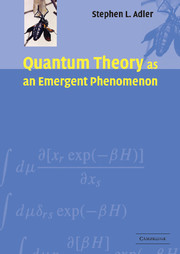 Quantum Theory as an Emergent Phenomenon
Quantum Theory as an Emergent Phenomenon Book contents
- Frontmatter
- Contents
- Acknowledgements
- Introduction and overview
- 1 Trace dynamics: the classical Lagrangian and Hamiltonian dynamics of matrix models
- 2 Additional generic conserved quantities
- 3 Trace dynamics models with global supersymmetry
- 4 Statistical mechanics of matrix models
- 5 The emergence of quantum field dynamics
- 6 Brownian motion corrections to Schrödinger dynamics and the emergence of the probability interpretation
- 7 Discussion and outlook
- Appendices
- References
- Index
3 - Trace dynamics models with global supersymmetry
Published online by Cambridge University Press: 17 March 2010
- Frontmatter
- Contents
- Acknowledgements
- Introduction and overview
- 1 Trace dynamics: the classical Lagrangian and Hamiltonian dynamics of matrix models
- 2 Additional generic conserved quantities
- 3 Trace dynamics models with global supersymmetry
- 4 Statistical mechanics of matrix models
- 5 The emergence of quantum field dynamics
- 6 Brownian motion corrections to Schrödinger dynamics and the emergence of the probability interpretation
- 7 Discussion and outlook
- Appendices
- References
- Index
Summary
In Section 2.4, we illustrated the trace dynamics formalism by constructing the trace dynamics analog of a simple field theory model, in which a Dirac fermion interacts with a scalar Klein–Gordon field. Much of the recent literature in quantum field theory has concerned itself with supersymmetric theories, in which invariance under the Poincaré group has been extended to invariance under the graded Poincaré group, and theories of this type are considered likely to play a central role in the ultimate unification of the forces. Our aim in this chapter (which can be omitted on a first reading) is to show that the trace dynamics formalism naturally extends to globally supersymmetric theories. Specifically, we shall see that, when there is a global supersymmetry, there is a conserved trace supersymmetry current with a time-independent trace supercharge Qα, that together with the trace four momentum obeys the Poincaré supersymmetry algebra under the generalized Poisson bracket of Eq. (1.11a). We shall illustrate this statement with three concrete examples, the trace dynamics versions (Adler 1997a,b) of the Wess–Zumino model (Section 3.1), the supersymmetric Yang–Mills model (Section 3.2), and the so-called “matrix model for M theory” (Section 3.3). These three examples are worked out using component field methods; we close in Section 3.4 with a short discussion of a superspace approach, and of the obstruction that prevents the construction of a trace dynamics theory with local supersymmetry.
The Wess–Zumino model
We begin with the trace dynamics transcription of the Wess–Zumino model.
Information
- Type
- Chapter
- Information
- Quantum Theory as an Emergent PhenomenonThe Statistical Mechanics of Matrix Models as the Precursor of Quantum Field Theory, pp. 64 - 74Publisher: Cambridge University PressPrint publication year: 2004